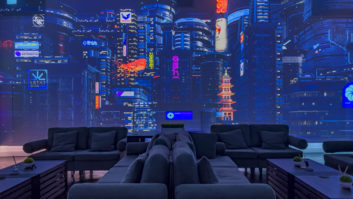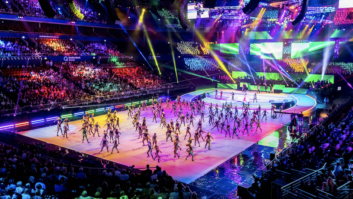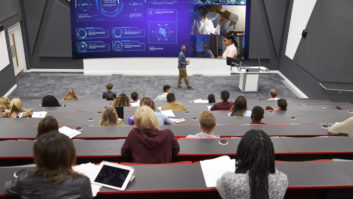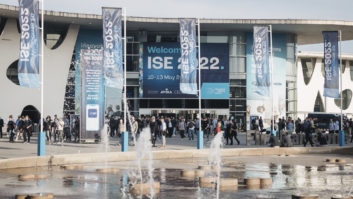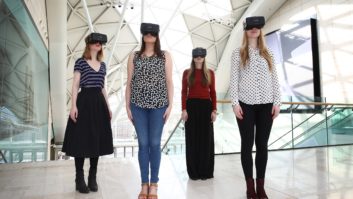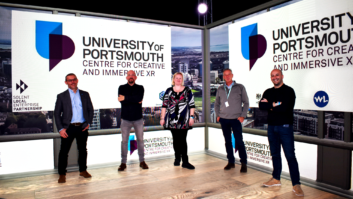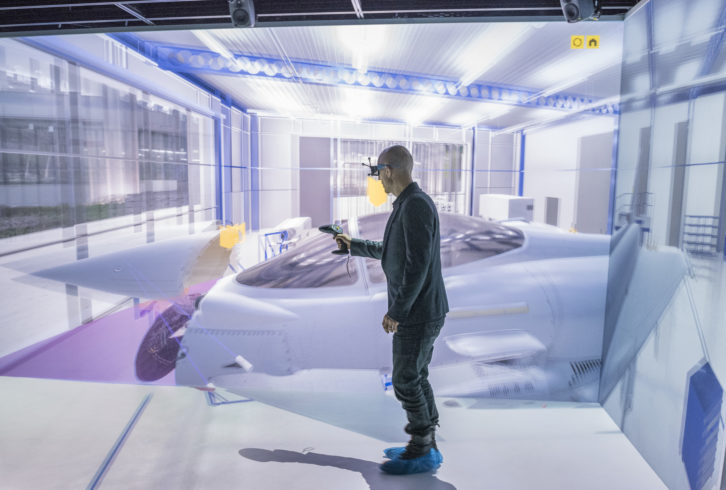
That which was once the stuff of science fiction – like a portable device that would enable its user to communicate with anyone, anywhere – has a habit of becoming an everyday reality. Ian McMurray finds out how an example of that phenomenon is rapidly infiltrating major organisations.
If you know that a warp drive won’t function without a dilithium crystal, and that diseases can be simply diagnosed with a tricorder, you’ll certainly be familiar with the concept of a holodeck. A holodeck was virtual reality pretty much before any of us had even heard of virtual reality. For those not in the know: the holodeck was a key feature of the USS Enterprise of Star Trek fame, boldly going where no man has gone before, that created an imaginary world in which crew members could experience, and interact with, ‘real’ things and events. It could be used for recreation – or for work.
Fast forward some 30 years, and powerful – and increasingly affordable – headsets such as the Oculus Quest are enabling new forms of immersive entertainment, creating a compelling (and occasionally disturbing and disorientating) alternative reality.
Potential
“One of the biggest misconceptions about VR is that it is just used for leisure activities like gaming,” points out Andrew Hug, vice president, SE EMEA at Poly (previously Polycom). “It has huge potential in the workplace.”
So what are the corporate applications for virtual reality?
“If a corporation utilises technology from a laptop to a security terminal, then VR represents a medium to effectively and procedurally train employees on a virtual version, where they can do no damage and learn by their mistakes,” says Frank Reynolds, European marketing manager at Antycip Simulation. “If they have buildings with emergency regulations, or simply a large building that requires familiarity for navigation, then a virtual replica can help provide training. Security can also be an area for VR; we know that a large bank in London, for example, uses a virtual twin of its building for threat analysis tied in with its real security systems, and disaster planning scenarios for fire and so on.”
“Ultimately,” he continues, “VR can be used to tackle almost any topic you consider to be important to your organisation – from training, to design and data reviews, to communications such as virtual town halls to a sales and marketing tool.”
Sales tool
Sales and marketing as an application for VR is frequently mentioned. It’s one that’s applicable to many organisations – like Logitech.
“One area where Logitech sees VR adding real value is in our sales cycle,” says Jonathan Tracey, director of sales enablement, Logitech Video Collaboration. “As our video collaboration team has grown, so has the size and breadth of the solutions that we’re selling. With a broad portfolio of products, it’s now more complex to bring a complete demo kit onsite.”
“To overcome this challenge, we’re currently in the process of developing a virtual reality product catalogue,” he continues. “This catalogue will feature, in VR, all our solutions in different room configurations, which can be individually explored by a customer. Our plan is to share these pre-loaded headsets with our customers so they can then browse in their own time and explore the product range ‘in person.’”
“VR also provides some great advantages that allow us to do things that we couldn’t do in person,” Tracey adds. “For example, we’re able to lay visualisations over a room layout, showing a customer the coverage area of expansion mics. We can also put the viewer inside the lens of the conference camera they are demoing, so they can test the difference between a 90° FOV and 120° FOV camera. And as a sales tool, the headsets are able to provide us with analytics on what solutions our customers were most interested in, so we can be more focused in our follow up conversations.”
Dave Elliott, business development manager at Holovis, has another example of how VR can support sales. “Within the automotive industry for example,” he says, “the same data sets that are used to review and amend the design can be utilised by customers in showrooms to sit in and experience virtual vehicles, customise the interior and exterior before placing their order. This is useful when vehicles are in production but haven’t made it to the showrooms yet, speeding up the buying cycle.”
Reducing hidden costs
Also high on the list are education and training. “I see VR as advantageous for educational applications in any form and shape, ranging from corporate training to student learning and research in schools, universities and medical facilities,” notes Dr Gregory Mirsky, product manager at Atlona. “VR is especially useful in applications where real-time environments and situations are challenging to reproduce in a real-world setup.”
“VR training apps can help to reduce some of the hidden costs of employee training, such as employee time, travel, facilities, materials and equipment. Another plus for VR training is that costly, difficult or otherwise-impossible scenarios and simulations become within reach,” echoes Sol Rogers, CEO and founder of REWIND.
Igloo Vision’s managing director, Colin Yellowley, has seen numerous corporate installations.
“An Igloo has been used by wastewater company Lanes Group to ‘gamify’ its training programme, which has proved more effective than a traditional classroom setting,” he says. “Lendlease has used its VRoom to help speed up processes across departments including projects, sales, safety and design. The Vodafone Foundation recently used a 21-metre dome to host its 25th anniversary of charitable giving.”
“And,” he goes on, “Welsh Water told us that its use of VR technology paid for itself on the first large scheme, and there are over 50 schemes coming through the process.”
Hardware challenges
It seems, then, that there is a growing realisation that VR can be extraordinarily useful – but, in hardware terms, are we there yet? Few audiovisual applications demand more of the supporting technology than VR does. In the case of room-sized virtual environments, projectors play a key role.
“For the high-end virtual rooms that Antycip works on,” explains Reynolds, “the move to shared dynamic multiple points of view by the leading projector manufacturers is a big step forward. It provides users with the benefits of multiple points of view that head mounted display – HMD – users have, without the isolation and, by comparison, lower resolution of HMDs.”
That’s something Digital Projection has been working on, as the company’s EMEA sales and marketing manager Dirk Siedle explains.
“From our perspective, the introduction of Multiview technology with our INSIGHT 4k HFR 360 gives users the option to install caves or power walls that truly offer additional benefit for working in 3D with teams,” he explains. “Up to six users get their correct perspective rendered in 3D and therefore have, at any given time, the correct 3D image visible to them – whereas in the past there was only one person tracked and everybody else did not get their correct perspective, which meant that team work in VR/3D was not really possible.”
There’s also the need for the background infrastructure to support very high resolution, high frame rate video at zero latency – the latter two being especially important if the nausea that is occasionally associated with VR is to be avoided.
Industry first
At InfoComm, Atlona demonstrated what it said was an industry first. “Using our OmniStream AV encoders, decoders and USB over IP adapters, the demonstration proved how OmniStream can support VR-specific 2,160 x 1,200 resolutions, working at 233 million pixels per second and with a 90Hz refresh rate,” recalls Mirsky. “The takeaway for integrators and tech managers is that OmniStream’s core benefits around bandwidth efficiency and low-latency distribution apply to the very advanced requirements of managing VR environments over IP networks.”
And then, there’s HMD technology. “Improvements in lens and panel technology have given us hardware that has superb visual quality,” notes Rogers. “Take the HP Reverb for example, with a staggering 2,160 x 2,160 panel per eye, a 114-degree field of view, inside-out tracking and lightweight design. It delivers across the board and tackles some of the pain points associated with VR solutions.”
By comparison, the Oculus Quest favoured by gamers offers only around half that level of resolution.
Holovis’s Elliott acknowledges the strides are being made – but also points out the potential for confusion.
“Whilst significant leaps have been made in the VR space regarding the hardware, image quality and hand tracking, we often find that customers are looking for an AR solution when they describe their intent behind the solution being scoped,” he points out. “The advances in this area have been huge in the last six months with hardware getting sleeker and the quality of images that can be overlaid on to the real world and interacted with really advancing.”
Misconceptions
There are many misconceptions about VR. It’s not, as Elliott points out, the same as AR. It doesn’t, for example, always have to mean wearing a headset. It isn’t necessarily expensive. It won’t deliver new information – it will only make existing information more accessible, more engaging and more meaningful. Most important, perhaps, is the perception that VR is only about leisure and entertainment. As Igloo Vision’s Yellowley points out: the world’s most prominent business consultancies think otherwise.
“Recently, we’ve seen a wave of interest in Shared VR from consulting and advisory clients – like PwC, EY and Accenture – who have been installing our technology and/or referring us to their clients,” he notes. “This suggests that VR is no longer being viewed as a fad or a novelty, but as a valuable enterprise tool that can help businesses to work faster, smarter and safer than ever before.”
He has an ally in REWIND’s Rogers. “Virtual reality has been around for a long time, but the early iterations of the technology were expensive and cumbersome,” he says. “Now, as VR is becoming more accessible and reliable, it is being rapidly adopted across a whole range of industries – from architecture to tourism. In the current climate of constant technological advancement and economic uncertainty, organisations need to find new ways to drive efficiency, and VR is working. It is already revolutionising workflows and saving businesses money by improving processes.”
“The business use cases have proved that VR is much more than a gaming medium: it really does have the ability to change the world for the better,” he concludes.
Watching with interest
It becomes clear, in talking to the industry – long regarded as something of a specialist niche – that forward-looking organisations of all types are keeping a close eye on developments in VR because of the potentially transformational benefits it offers. Those developments are ongoing – and it’s not just end users who are watching with interest. Today, for example, VR isn’t widely found in the traditional collaborative communication/huddle room market – but that’s not to say it never will be.
“VR will bring learning and training processes to life as it makes them highly interactive,” believes Poly’s Hug. “Collaboration and development of new ideas will be heightened thanks to contextual and visual representations of what could be. At Poly, we thrive on pushing the limits of communication and collaboration and look forward to the enhanced human-first communication that VR will bring. We are asking ‘what’s next?’ – not ‘what if?’”
When it comes to VR, it seems as if increasing numbers of CEOs will be echoing the immortal words of Captain Jean-Luc Picard: “Make it so.”
